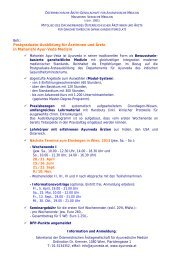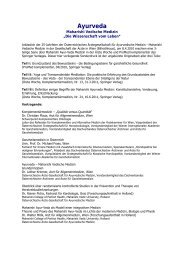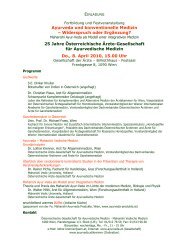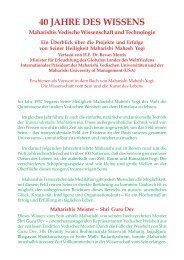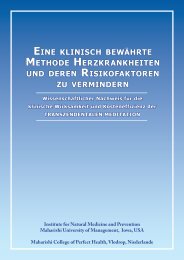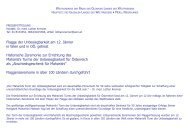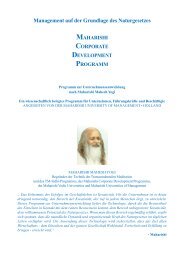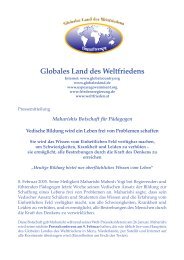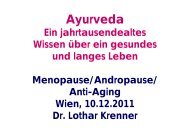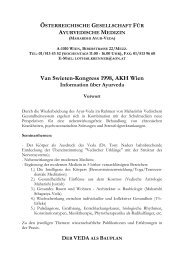Summary of Research Findings
Summary of Research Findings
Summary of Research Findings
You also want an ePaper? Increase the reach of your titles
YUMPU automatically turns print PDFs into web optimized ePapers that Google loves.
Antioxidant <strong>Research</strong> (continued)<br />
10. Title<br />
Inhibition <strong>of</strong> Low-Density Lipoprotein Oxidation by Oral Herbal Mixtures Maharishi Amrit Kalash-4 (MAK-4) and<br />
Maharishi Amrit Kalash-5 (MAK-5) in Hyperlipidemic Patients<br />
Publication<br />
The American Journal <strong>of</strong> the Medical Sciences, Vol. 314, No. 5, pp. 303-310, 1997.<br />
Authors<br />
Vidya Sundaram, M.D.,* Atef N. Hanna, Ph.D.,** Gary P. Lubow, M.D.,** Lata Koneru, M.D.,† James M. Falko,<br />
M.D.,* and Hari M. Sharma, M.D.**<br />
Conducted at<br />
*Department <strong>of</strong> Internal Medicine and **Department <strong>of</strong> Pathology, College <strong>of</strong> Medicine, The Ohio State<br />
University, Columbus, OH<br />
†Department <strong>of</strong> Internal Medicine, Riverside Methodist Hospital, Columbus, OH.<br />
<strong>Summary</strong><br />
Low-density lipoprotein (LDL) oxidation is central to the pathogenesis <strong>of</strong> atherosclerosis. This study evaluated<br />
the antioxidant activity <strong>of</strong> MAK-4 and MAK-5 in vivo. Ten hyperlipidemic patients prescribed stable hypolipidemic<br />
therapy were treated with MAK-4 and MAK-5 for 18 weeks. Plasma lipoprotein, plasma lipid peroxide,<br />
and LDL oxidation studies were performed every 6 weeks. Apolipoprotein A, apolipoprotein B, and lipoprotein<br />
(a) levels were measured at baseline and 18 weeks. After 12 weeks <strong>of</strong> treatment with MAK-4 and MAK-5, a timedependent<br />
increase in the lag phase and delay in the propagation phase <strong>of</strong> oxidation <strong>of</strong> LDL by Cu +2 and<br />
endothelial cells was seen. Lag phases at baseline and after 6, 12, and 18 weeks <strong>of</strong> MAK-4 and MAK-5 ingestion<br />
were 6.66 hours ± 0.19 (mean ± standard error <strong>of</strong> mean), 6.77 hours ± 0.31, 7.22 hours ± 0.24, and 18.00<br />
hours ± 0.73, respectively, for Cu +2 -catalyzed LDL oxidation. Lag phases were 14.89 hours ± 0.77, 13.33 hours<br />
± 0.50, 20.22 hours ± 0.76, and 20.00 hours ± 0.79, respectively, for endothelial cell-induced LDL oxidation.<br />
The levels <strong>of</strong> plasma lipid peroxide did not change significantly. No significant changes were seen in the plasma<br />
lipoproteins and the levels <strong>of</strong> apolipoprotein A, apolipoprotein B, and lipoprotein (a). The results show that<br />
MAK-4 and MAK-5 inhibit LDL oxidation in patients with hyperlipidemia. Therefore, MAK-4 and MAK-5 may be<br />
useful in the prevention and treatment <strong>of</strong> atheroslerosis.<br />
30



